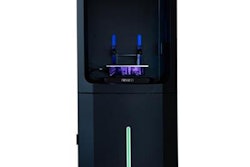
Remember those Legos you played with as a child (or stepped on in the middle of the night as a parent)? Well, those building blocks that once inspired you to build have inspired researchers to create a technology that will likely have an impact in the medical and dental fields.
According to new research published on July 23 in Advanced Materials, scientists are using 3D printing to build microgel-loaded modular microcages. These microcages can be used to build "scaffolding systems" that can be "be extended to a wide range of materials for improved biological performance," according to the study authors.
Each brick used as part of the scaffolding is 1.5 mm cubed, or roughly the size of a small flea.
Researchers at the Oregon Health & Science University (OHSU) School of Dentistry and School of Medicine are working together on the possibilities for these tiny bricks and planning big things for their use in the future. They have partnered with researchers at New York University and Mahidol University in Thailand to develop and evaluate the technology.
"The 3D-printed microcage technology improves healing by stimulating the right type of cells to grow in the right place, and at the right time," said study co-author Ramesh Subbiah, PhD, in a release from OHSU. "Different growth factors can be placed inside each block, enabling us to more precisely and quickly repair tissue."
David Rice, DDS, clinical editor for DrBicuspid.com, said he was excited to see the study and to see yet another use for 3D printing in the dental operatory.
"From model building to splints to surgical guides and clear aligners, 3D printing is revolutionizing dentistry today," Dr. Rice said. "Now imagine our ability to print the infrastructure for growing teeth and beyond. It's exciting to think about what could lie ahead with this research out of Oregon and how it could benefit our patients."
Certainly, there is still plenty of work to be done before dentists will be using this technology. Next steps for the research team include reportedly exploring the microcages' performance in bone repair, including the ability to repair more complex bone fractures in rats or larger animals.



















